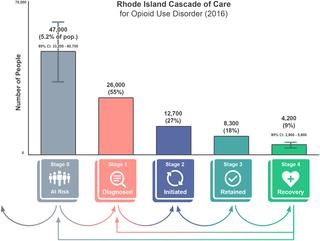Our official English website, www.x-mol.net, welcomes your
feedback! (Note: you will need to create a separate account there.)
Defining a recovery-oriented cascade of care for opioid use disorder: A community-driven, statewide cross-sectional assessment.
PLOS Medicine ( IF 10.5 ) Pub Date : 2019-11-19 , DOI: 10.1371/journal.pmed.1002963 Jesse L Yedinak 1 , William C Goedel 1 , Kimberly Paull 2 , Rebecca Lebeau 2 , Maxwell S Krieger 1 , Cheyenne Thompson 2 , Ashley L Buchanan 3 , Tom Coderre 4 , Rebecca Boss 5 , Josiah D Rich 1, 6 , Brandon D L Marshall 1
PLOS Medicine ( IF 10.5 ) Pub Date : 2019-11-19 , DOI: 10.1371/journal.pmed.1002963 Jesse L Yedinak 1 , William C Goedel 1 , Kimberly Paull 2 , Rebecca Lebeau 2 , Maxwell S Krieger 1 , Cheyenne Thompson 2 , Ashley L Buchanan 3 , Tom Coderre 4 , Rebecca Boss 5 , Josiah D Rich 1, 6 , Brandon D L Marshall 1
Affiliation

|
BACKGROUND
In light of the accelerating and rapidly evolving overdose crisis in the United States (US), new strategies are needed to address the epidemic and to efficiently engage and retain individuals in care for opioid use disorder (OUD). Moreover, there is an increasing need for novel approaches to using health data to identify gaps in the cascade of care for persons with OUD.
METHODS AND FINDINGS
Between June 2018 and May 2019, we engaged a diverse stakeholder group (including directors of statewide health and social service agencies) to develop a statewide, patient-centered cascade of care for OUD for Rhode Island, a small state in New England, a region highly impacted by the opioid crisis. Through an iterative process, we modified the cascade of care defined by Williams et al. for use in Rhode Island using key national survey data and statewide health claims datasets to create a cross-sectional summary of 5 stages in the cascade. Approximately 47,000 Rhode Islanders (5.2%) were estimated to be at risk for OUD (stage 0) in 2016. At the same time, 26,000 Rhode Islanders had a medical claim related to an OUD diagnosis, accounting for 55% of the population at risk (stage 1); 27% of the stage 0 population, 12,700 people, showed evidence of initiation of medication for OUD (MOUD, stage 2), and 18%, or 8,300 people, had evidence of retention on MOUD (stage 3). Imputation from a national survey estimated that 4,200 Rhode Islanders were in recovery from OUD as of 2016, representing 9% of the total population at risk. Limitations included use of self-report data to arrive at estimates of the number of individuals at risk for OUD and using a national estimate to identify the number of individuals in recovery due to a lack of available state data sources.
CONCLUSIONS
Our findings indicate that cross-sectional summaries of the cascade of care for OUD can be used as a health policy tool to identify gaps in care, inform data-driven policy decisions, set benchmarks for quality, and improve health outcomes for persons with OUD. There exists a significant opportunity to increase engagement prior to the initiation of OUD treatment (i.e., identification of OUD symptoms via routine screening or acute presentation) and improve retention and remission from OUD symptoms through improved community-supported processes of recovery. To do this more precisely, states should work to systematically collect data to populate their own cascade of care as a health policy tool to enhance system-level interventions and maximize engagement in care.
中文翻译:

定义阿片类药物使用障碍以恢复为导向的级联护理:社区驱动的全州横断面评估。
背景技术鉴于美国(US)的药物过量危机不断加速和迅速演变,需要新的策略来应对这一流行病并有效地吸引和保留阿片类药物使用障碍(OUD)患者的护理。此外,越来越需要新的方法来使用健康数据来确定 OUD 患者级联护理中的差距。方法和结果 2018 年 6 月至 2019 年 5 月期间,我们与多元化的利益相关者团体(包括全州卫生和社会服务机构的董事)合作,为新英格兰小州罗德岛州的 OUD 开发全州范围内、以患者为中心的级联护理服务,一个受阿片类药物危机严重影响的地区。通过迭代过程,我们修改了 Williams 等人定义的级联护理。用于罗德岛州,使用关键的国家调查数据和全州健康声明数据集来创建级联 5 个阶段的横截面摘要。 2016 年,估计约有 47,000 名罗德岛岛民 (5.2%) 面临 OUD(0 期)风险。同时,有 26,000 名罗德岛岛民提出了与 OUD 诊断相关的医疗索赔,占高危人群的 55% (第一阶段); 0 期人群中的 27%(12,700 人)显示出开始服用 OUD 药物(MOUD,第 2 期)的证据,18%(即 8,300 人)有保留 MOUD 药物的证据(第 3 期)。一项全国调查估计,截至 2016 年,有 4,200 名罗德岛岛民正在从 OUD 中恢复,占风险总人口的 9%。局限性包括使用自我报告数据来估计有 OUD 风险的人数,以及由于缺乏可用的国家数据源而使用国家估计来确定康复中的人数。 结论 我们的研究结果表明,OUD 护理级联的横断面总结可用作卫生政策工具,以识别护理差距、为数据驱动的政策决策提供信息、设定质量基准并改善 OUD 患者的健康结果。在开始 OUD 治疗之前增加参与度(即通过常规筛查或急性表现识别 OUD 症状)并通过改进社区支持的康复过程来改善 OUD 症状的保留和缓解是一个重要的机会。为了更准确地做到这一点,各国应努力系统地收集数据,以充实自己的级联护理,作为卫生政策工具,以加强系统级干预措施并最大限度地提高护理参与度。
更新日期:2019-12-03
中文翻译:

定义阿片类药物使用障碍以恢复为导向的级联护理:社区驱动的全州横断面评估。
背景技术鉴于美国(US)的药物过量危机不断加速和迅速演变,需要新的策略来应对这一流行病并有效地吸引和保留阿片类药物使用障碍(OUD)患者的护理。此外,越来越需要新的方法来使用健康数据来确定 OUD 患者级联护理中的差距。方法和结果 2018 年 6 月至 2019 年 5 月期间,我们与多元化的利益相关者团体(包括全州卫生和社会服务机构的董事)合作,为新英格兰小州罗德岛州的 OUD 开发全州范围内、以患者为中心的级联护理服务,一个受阿片类药物危机严重影响的地区。通过迭代过程,我们修改了 Williams 等人定义的级联护理。用于罗德岛州,使用关键的国家调查数据和全州健康声明数据集来创建级联 5 个阶段的横截面摘要。 2016 年,估计约有 47,000 名罗德岛岛民 (5.2%) 面临 OUD(0 期)风险。同时,有 26,000 名罗德岛岛民提出了与 OUD 诊断相关的医疗索赔,占高危人群的 55% (第一阶段); 0 期人群中的 27%(12,700 人)显示出开始服用 OUD 药物(MOUD,第 2 期)的证据,18%(即 8,300 人)有保留 MOUD 药物的证据(第 3 期)。一项全国调查估计,截至 2016 年,有 4,200 名罗德岛岛民正在从 OUD 中恢复,占风险总人口的 9%。局限性包括使用自我报告数据来估计有 OUD 风险的人数,以及由于缺乏可用的国家数据源而使用国家估计来确定康复中的人数。 结论 我们的研究结果表明,OUD 护理级联的横断面总结可用作卫生政策工具,以识别护理差距、为数据驱动的政策决策提供信息、设定质量基准并改善 OUD 患者的健康结果。在开始 OUD 治疗之前增加参与度(即通过常规筛查或急性表现识别 OUD 症状)并通过改进社区支持的康复过程来改善 OUD 症状的保留和缓解是一个重要的机会。为了更准确地做到这一点,各国应努力系统地收集数据,以充实自己的级联护理,作为卫生政策工具,以加强系统级干预措施并最大限度地提高护理参与度。











































 京公网安备 11010802027423号
京公网安备 11010802027423号